AI in Customer Service
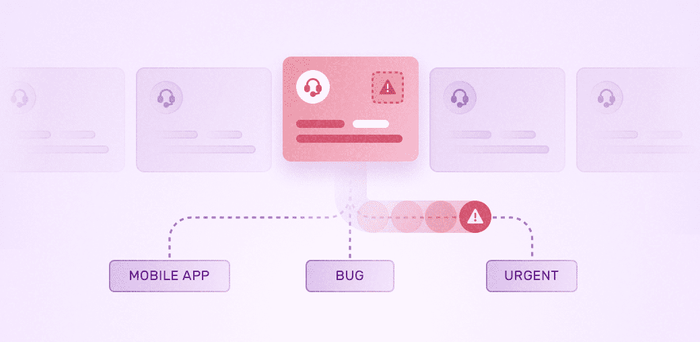
Customer service is an integral part of all businesses, clients want to feel heard. By automating different customer service activities with artificial intelligence tools, companies can provide faster and better responses to customers' queries, providing an exceptional experience.
Artificial intelligence is one of those ‘futuristic’ inventions that went mainstream in the movies and was, more often than not, portrayed as a threat to humans.
Remember The Matrix? A sci-fi film set in the future, where humans are controlled by a huge artificial intelligence system that tapped into their minds and created an illusion of a real world. Then, along came Neo, ‘The One’, who set out to crack open the Matrix and free humans from their so-called imprisonment.
Well, that was 20-odd years ago now, and needless to say, artificial intelligence hasn’t taken over. It has, however, made its way into everyday activities – sometimes without us realizing – positioning itself as more of a silent sidekick than an impending threat.
One area in which artificial intelligence has been making leaps and bounds is customer service. Since customer expectations are higher than ever, businesses are increasingly looking for advanced technological capabilities to bridge the customer expectation gap. Eighty-two percent of customers have left a company because of a bad customer service experience, an area that could be improved vastly by implementing artificial intelligence, and not extra manual labor.
Many businesses have already equipped their customer service teams with AI tools, who are using them in various ways – something we’ll cover later on in this article. However, there’s still a long way to go; today, just 15% of enterprises are using AI.
In this article, we’ll go over what artificial intelligence is, how it works, its various forms and applications, and the benefits it can deliver to customer service teams. Start reading from the very beginning, or jump to one of the sections below:
- What Is AI and how does it work?
- How AI can be used in customer service?
- Automatic ticket tagging
- Automatic ticket triaging and routing
- Detecting urgency and prioritizing issues
- Leveraging insights in real-time
- Leveraging chatbots and virtual assistants
- Automating data entry
- Customer service analytics
- AI-based auto-responses & response suggestions
- Facial recognition for frictionless ID and emotion analysis
- The benefits of AI in customer service
Let's get started!
What Is Artificial Intelligence and How Does It Work?
Artificial intelligence (AI) is the simulation of human intelligence by machines, including learning, decision-making, and self-correction. You might also hear the term augmented intelligence, another term for artificial intelligence, which some prefer to use since the latter often incites unrealistic fears linked to popular culture.
So how does artificial intelligence simulate the way the human brain works? AI-powered tools use different components that enable them to understand, analyze, manipulate, and, in some cases, generate information, most notably: Machine learning and Natural language processing (NLP).
Machine Learning
Machine learning is the science of computers acting without being explicitly programmed to do so. It uses algorithms (formulas) to solve problems, which become more advanced as machines are fed more data, and eventually, they learn how to predict and make decisions automatically. Let’s take a look at the three main forms of machine learning algorithms:
Supervised learning uses data sets that are already labeled to detect patterns and label new data sets.
For example, a machine learning algorithm that’s able to detect urgent support tickets because it has been trained using tickets that have already been tagged as urgent. It is able to spot patterns within text – words and expressions such as ‘right away’, ‘as soon as possible’’, ‘please help asap’ – and tag urgent tickets automatically.Unsupervised learning sorts data that isn’t labeled, according to similarities or differences. For example, a machine learning algorithm that makes recommendations for Netflix films and Amazon purchases by grouping similar movies or products together.
Reinforced learning sorts data that isn’t labeled but receives feedback (rewards and penalties) after performing actions.
For example, a machine algorithm that’s able to respond automatically to a customer query. Chatbots might not understand a customer query but respond in the best way they know-how. The feedback (reinforcement) will depend on the customer’s response and/or actions, for instance, a positive response, an upgrade, or upsell would represent a reward, while negative responses, abandoned conversations, or even customer churn would represent a penalty.
Some well-known examples of machine learning include spam detection, chatbots, and even self-driving cars. Ever wondered how phishing scams and other unwanted emails get sent directly to your spam filter, how chatbots respond immediately to your queries, or how self-driving cars automatically respond to nearby traffic? That’s AI at work.
Natural Language Processing
Natural Language Processing (NLP) is the subfield in machine learning focused on language and the latest tool in AI’s arsenal. It analyses language to understand the meaning and context behind human expressions (e.g. spoken conversation or a piece of text), enabling AI to take on more tedious roles of communication. Take Siri, Apple’s virtual assistant, for example. Siri speaks and interacts in a similar way to humans, with a few glitches of course. That’s NLP, processing language, making sense of text and speech, and presenting a solution.
While there’s still a long way to go before machine learning and NLP have the same capabilities as humans, AI is fast becoming a tool that customer service teams can rely upon. By 2035, AI technologies are projected to increase business productivity by up to 40%.
Gartner predicts that, by 2021, 70 percent of organizations will assist their employees’ productivity by integrating AI in the workplace. Whether you’ve started making plans to implement AI into your business, or you have a solid strategy in place, let’s take a look at how AI can be used in customer service.
How AI Can Be Used in Customer Service?
By adding AI-powered tools to your customer service process, you can improve customer experience (CX), loyalty, and brand reputation, all of which have many wider business implications such as lower customer churn, higher revenues, less staff turnover, increased growth, etc.
With so much choice out there and businesses competing for market share, AI is more relevant than ever. Companies that excel at customer experience grow revenues 4-8% above the market. With this in mind, organizations need to stand out and disrupt the market by leveraging technology to provide an exceptional experience to their customers.
“People want what’s best for them, and they can switch on a dime, because there’s always a new disruptor disrupting the last disruptor. So companies should just strive to keep changing and adapting to their customers’ needs.”
It’s no longer about innovative marketing campaigns that make big statements. Customers want to feel like they’re being listened to – 84% of customers say being treated like a person, not a number, is very important to winning their business.
Customers also expect faster responses. Forgotten passwords, refunds, bugs… These are all queries that need quick answers. If a customer is left waiting too long, it won’t be long before they switch to a provider that offers a faster and better customer experience. According to McKinsey, 75% of online customers expect help within 5 minutes.
The quantity of tickets that customer service teams resolve is important because, really, every customer should receive a response, since just one unhappy customer will tell between 9-15 people about their experience, while 13% of unhappy customers will tell more than 20 people. In some cases, you might be able to resolve many tickets by resolving one issue that many customers are talking about. For example, Google Calendar was down for users around the world for three hours, resulting in many customer queries:
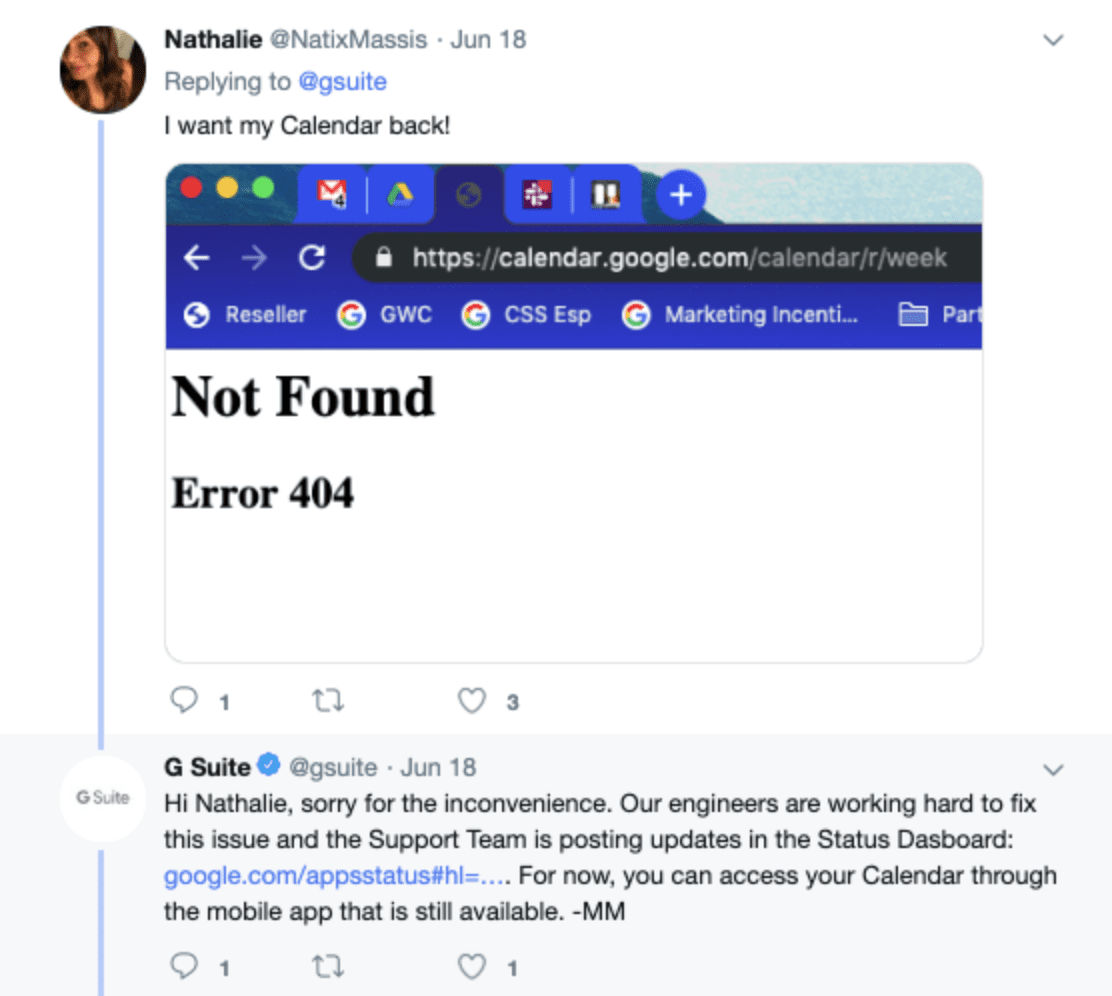
Not only was Google able to respond individually to each of these queries, but it was also able to solve the Google Calendar issue and appease a large number of customers in one fell swoop.
The quality of customer service responses, however, is just as important as the quantity of tickets resolved. If a customer is unhappy with the solution or response, they might switch to another company regardless of the quick turnaround. Sixty-six percent of B2B and 52% of B2C customers stopped buying from a brand after a bad customer service interaction.
Now, if you’re responding quickly, appropriately, and personally to each and every customer query manually, you’ll probably resolve a maximum of 50 tickets per day, per agent. But what if your company receives thousands of tickets every day? You’re going to need AI backup!
Communicating with customers on a personal level, in real-time, and effectively needs to be at the forefront of every business’ customer service strategy. It’s a lot to ask from humans alone, but with the help of artificial intelligence, a great customer experience is within every company’s reach.
Let’s look more closely at how AI tools are already being used in customer service.
Automatically tag customer service tickets
Customer service teams handle vast amounts of tickets every day – reading, processing, and tagging them so that they’re routed to the correct team to deal with the issue. It’s a monotonous and time-consuming task and one that is slowly being replaced by AI tools such as text analysis.
Text analysis is the process of automatically obtaining information from text, analyzing it, and auto-tagging it. However, rather than spending hours going through thousands of tickets, text analysis models can whip through them in seconds!
There are many models that you can use to tag your tickets, depending on the problem you’re trying to solve or what you consider most important to your business. For example, you might want to automatically tag your tickets according to topic (Billing Issues, Account Issues, Bugs, How to X, Feature Requests, etc.) in which case you’d choose a topic detection model. If you want to get a quick overview of how people feel about your brand, you’d use a sentiment analysis model to automatically separate tags into positive and negative.
Investment management solution company Archer uses AI to tag around 6,000 tickets a day. Most of their traffic is from emails, dealing with everything from live trading and reconciliation on stocks, to account maintenance requests and cash withdrawals.
Before they implemented MonkeyLearn into their Zendesk software, agents were spending far too much time going through stockpiles of tickets, instead of using their expertise to solve problems. Time was being wasted sending tickets from one person to the next until they eventually reached the right team member to deal with each problem.
The process started with the ‘quarterbacks’, those who sorted the tickets. They’d tag and assign tickets to a team, and a person within that team would assign an action to that ticket. Archer wanted to determine the action that was required for each ticket within 45 minutes of receipt. However, they weren’t always hitting this mark, since team members were having to open every single ticket, read its content, and tag them manually.
To deal with their enormous volume of tickets, Archer turned to automation with MonkeyLearn. They’re now able to predict the action required automatically using AI, which has led to faster response times. Instead of 15-20 minutes, tickets are now assigned and tagged in under 7 minutes, which is a big win for customer satisfaction.
“We have cut down our response time in half, which is significant,” said Alyssa – Wilkowski, Senior Programmer Analyst at Archer and Zendesk Certified Support Admin. “Our customer response has become more efficient and more targeted and we’re getting the right responses out right away.”
Of team leaders, Alyssa said: “their whole morning used to be sorting and tagging tickets and now, thanks to MonkeyLearn and automated tagging, the team leaders’ mornings are spent resolving clients’ requests”.
“With the quarterbacking job now automated, the team leaders are now freed to use their experience and expertise to find solutions for our customers.”
When it comes to financial operations, processes are often repetitive, which is another reason why Archer implemented MonkeyLearn.
“We’ll do the same processes for over 50 different financial services companies or clients, so we use AI to build repeatable, consistent service models using Natural Language Processing…” said Alyssa.
Not only are employees at Archer happier, their clients, and their clients’ customers are happier too. Overall response times are more efficient, customers feel like they are being listened to and, more importantly, they’re not left waiting in a queue.
Automatically triage and route tickets
Triage powered by NLP technology is able to understand the content of a support ticket to ensure it gets to the right agent. Once tickets have been automatically tagged, AI tools automatically route tickets to the right person, quickly and effectively.
AI tools are faster, more accurate and more objective than humans, and allow you to auto triage and route tickets in various ways, based on sentiment, topic, language, keywords, and urgency. For example, a machine learning model can be trained to detect and tag tickets by topics, such as Discount, Shipping Problem and Product Availability. Tickets tagged with Discount will automatically be routed to sales teams that deal with inquiries about pricing, while tickets tagged with Shipping Problem and Product Availability will be routed to support teams that can help solve these issues.
David Harrison, Customer Experience Operations Analyst at SeatGeek, a ticket search engine that makes finding tickets to live entertainment super easy, says that his team is using AI tools for automated routing, agent assist, and soon, for automated responses – starting with low risk and low volume questions.
By using AI tools, they are now self-serving about 7% of their ticket volume (SeatGeek receives about 1400 tickets/day).
David says, “The biggest win has been auto-routing so far, it saves us about 14 agent hours/day.”
Detecting urgency and prioritizing issues
Sixty-four percent of consumers and 80% of business buyers said they expect companies to respond to and interact with them in real-time. While it’s impossible for humans to work 24/7, machines can work around the clock to deliver timely and relevant responses. Using AI tools like urgency detection and sentiment analysis, companies are able to detect urgent issues as soon as possible. That means customer agents can deal with the issue faster and avoid customer churn, as well as a potential PR crisis.
Did you ever hear the story about the chicken that crossed the road, but didn’t quite make it to its destination? Well, according to fast-food chicken chain KFC that’s kind of what happened when some of their UK stores ran out of chicken. But, that was the least of their worries. Angry customers took to social media to voice their complaint. Thanks to the quick detection by AI tools, KFC was able to respond before news outlets got hold of the story and because they know their audience, they responded in the best way possible – by making light of the situation. Not only were they able to protect their brand’s reputation, they even gained followers.
Leveraging insights in real-time
As AI advances, machines are getting better at interpreting unstructured data from both text and voice conversations, meaning businesses are receiving more reliable and insightful data than ever before. AI is able to keep on top of customer issues, whether on support tickets, social media, emails, voice messages and so on, helping customer service teams not just handle issues but also interpret data in a way that improves their processes.
By merging AI and data, customer service is able to:
- Listen to customers on a whole new level
- Know what customers want
- Increase customer engagement
- Gain a deeper and better understanding of the customer
Sophisticated AI tools are the key to unearthing customer insights, allowing customer services to perform more effectively and craft more personalized and relevant responses.
Businesses can also use voice biometrics driven by AI to help provide a safe, secure, and fast service within call centers. Agents are able to identify customers based solely on a caller’s unique voiceprint, respond more efficiently, and make smarter decisions by having access to real-time, insight-based directions. For example, AI can group all current and historical data about a specific caller in seconds, and present the agent with the most likely reason for the call. Or, if the caller is complaining about a product, AI-based tools could provide an agent with possible responses based on data collected about this product.
For example, AI solution Cogito is already empowering customer support agents by helping them build a better rapport with customers on every call. By analyzing voice signals in phone conversations, Cogito is able to provide real-time guidance, help agents tailor their speaking style, and send instant feedback about agent call performance and customer perception.
Using this AI tool, customer service teams have been able to drastically improve the customer experience by:
- Adjusting their communication style and improving rapport with customers
- Engaging in more emotionally connected conversations, leaving both customers and agents more satisfied
- Listening more effectively and speaking more confidently and concisely
Let’s take a look at some customer experience results from companies that are using Cognito AI:
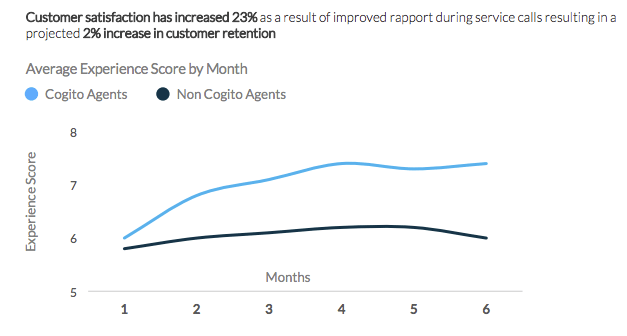
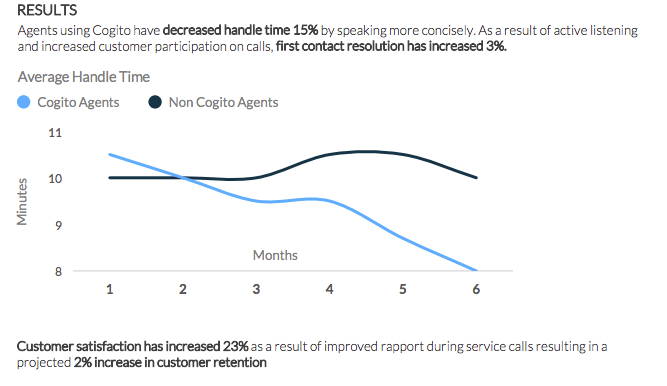
Leveraging chatbots and virtual assistants
A lot of customer service teams are now using chatbots and virtual assistants to help manage customer queries and needs. Consumers are keen to interact with chatbots because they predict the following potential benefits – 64% believe they’ll be to get 24-hour service and 55% predict they’ll get instant responses to inquiries and answers to simple questions. While it’s clear that customers want immediate responses any time of the day, every day, AI-powered tools are also a blessing for customer service agents because they’re able to offer faster responses, better customer experiences, prioritize urgent issues and focus on more important tasks.
Chris Fugitt, Director of Customer Experience at ProTrainings, says that his team is using chatbots to help customers with common questions and requests, which has allowed them to focus less on repetitive questions and spend more time on more complex, higher-value support.
“Our bot can also assist customers with creating their user accounts and begin walking them through parts of the onboarding process [...], transfer the chat to a human agent if the customer requests that – or the bot determines that's best. They also handle the majority of our live chats, and generate the majority of our inbound leads”.
Chris says that the bot at Protrainings has improved the CX because it’s up and running 24/7, enabling customers to receive immediate answers to common questions at any time.
Chatbots and virtual assistants, like Siri and Alexa, can quickly look up product information – a task that generally takes up 20% of support agents’ time – and respond to a customer’s query instantly. For example, if an agent doesn’t know how to advise a customer who’s been locked out of their account, they’ll need to search internal documentation for that information. Instead, an AI-powered chatbot can analyze the support ticket and gather the relevant information about ‘gaining access to accounts’ to help the customer agent deliver an immediate response.
Virtual assistants, like Alexa for Hospitality, can help deliver a great customer experience by becoming hotel guests’ virtual concierge. In a similar way to chatbots that make tasks simpler for customer support agents, Alexa simplifies tasks for guests. Things like playing music, ordering towels, controlling in-room temperature or lighting, finding local restaurants and attractions, calling, and even checking out are made easier through artificial intelligence. Through the power of voice and machine learning, guests can engage naturally with Alexa while Alexa gets smarter over time.
In some situations, a customer might feel more comfortable speaking directly to a person, which is the case for customers at investment management software company Archer. Alyssa said that because they deal with a person’s money, customers prefer to talk to a person rather than a bot.
Automating data entry
Perhaps one of the more straightforward uses of AI, but one that translates into many tasks, is gathering basic information.
AI tools like text extractors can pull out entities (persons names, company names, etc), emails, addresses, prices, phone numbers, and keywords, relieving customer agents of the task of reading, copying and pasting information into a spreadsheet, or gathering relevant information for analysis of a particular product or feature.
Customer service analytics
AI can also help find out what a customer thinks about your customer service interactions. By analyzing interactions on social media, in emails, chats, support tickets, and so on, you can find out if customers are happy or angry about how you deal with situations.
A sentiment analysis tool, for example, would split interactions into positive and negative, and if you want to go even deeper into your analysis, you could use aspect-based sentiment analysis to find out where your customer service teams are going wrong, or where they’re hitting the mark. Perhaps a customer feels like they’re being brushed off because an agent responds with a link, or maybe a customer loves the ‘friendly and personalized service’ you offer. You can even compare your interactions with those of your competitors to see if you could improve aspects of your customer service such as tone, personalization, effectivity, etc.
Take a look at these results from tweets mentioning the four big telecommunication carriers (Verizon, T-Mobile, AT&T, Sprint) which have been classified by MonkeyLearn:
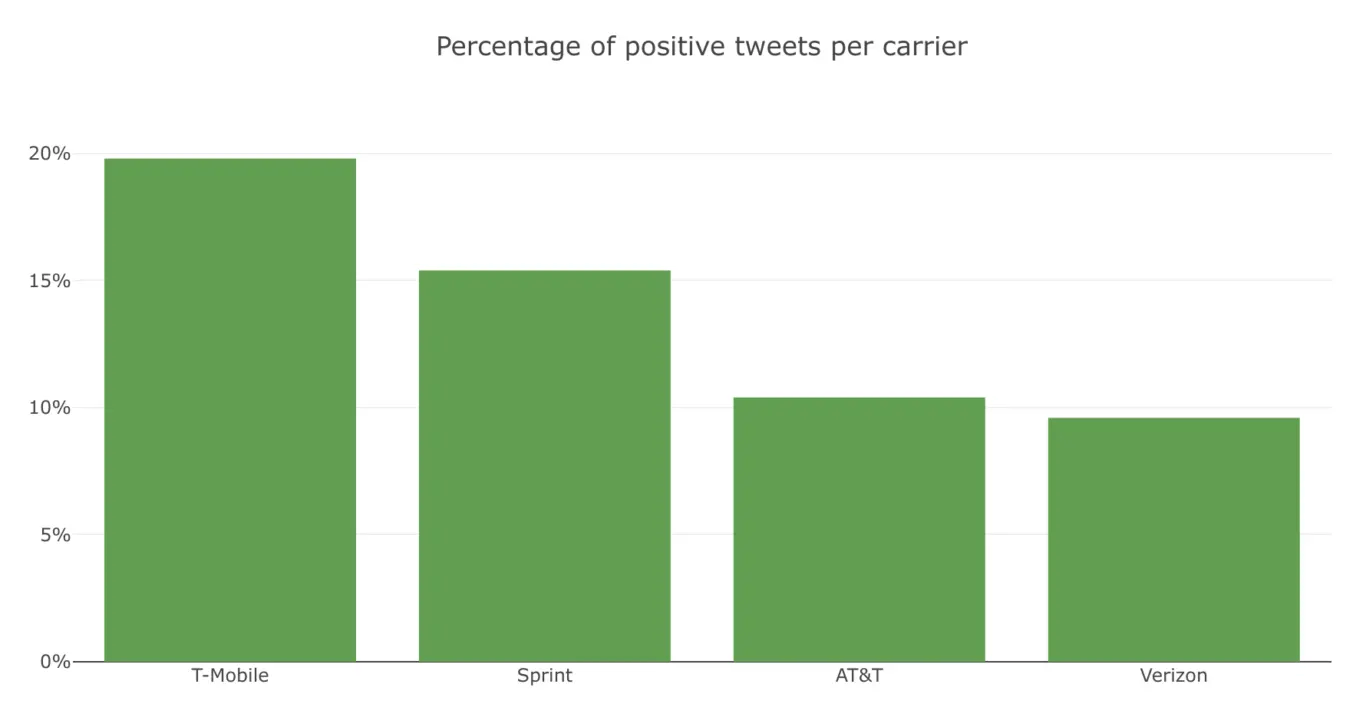
It’s clear to see that T-Mobile is winning when it comes to customer support, with 20% of positive tweets. Now, to find out what these positive tweets are mentioning, we’d need to run a keyword analysis. Here’s what we discovered. Many of the keywords are names of the customer support team, which indicates uses are engaging with T-Mobile customer support agents and addressing them on a first name basis. On their tweets with replies page, agents often reply with emojis and gifs, and even talk about unrelated topics. Verizon’s tweets, on the other hand, were dry and professional. Since the company received the fewest positive interactions, they might come to the conclusion that they need to improve their tone, language, and approach in customer communication
AI-based auto-responses & response suggestions
Some teams use AI to deliver auto-responses. The big advantage here is that you can reply to customers 24/7.
This is great when dealing with straightforward issues that don’t necessarily require human input. Issues like forgotten passwords, creating accounts, etc. However, auto-responses are not always ideal when dealing with more complex issues. If a customer needs help and receives an unhelpful auto-response, the customer is likely to become more frustrated.
In call centers, AI can be useful for response suggestions. Let’s say an agent is on a call and voice recognition deduces the subject matter and offers the agent possible responses, this can help an agent speed up the process and drastically improve their customer service.
Think about all those extra needless minutes you’ve spent on the end of the line, listening to elevator music while a customer agent looks for relevant information or passes you onto another agent. This is time that support agents and customers could win back with AI.
Facial recognition for frictionless ID and emotion analysis
Another AI tool used in customer service is facial recognition, a fast and frictionless form of identification and a quick way to identify emotions – visual sentiment analysis if you like. It’s only a matter of time before it’s applied for context and emotion-driven hyper-personalization to adapt pricing, communication, and even product based on a person’s context and mood of the moment.
Not only will this mean that brands will be able to target customers, but they’ll also be able to speed up customer service processes – passwords, pins, check-ins, data entry fields, and tickets could become a thing of the past. The Lufthansa Group is already using automated kiosks with facial recognition technology at Los Angeles International Airport to identify passengers and allow them to board the plane within a few seconds – speeding up boarding by 50%!
The Benefits of AI in Customer Service
AI tools are revolutionizing customer service and it’s only a matter of time before they become intertwined with every aspect of a company’s customer support process, from tagging and routing tickets to responding to emails and predicting a customer’s next move.
Customers are after seamless interactions and personalized engagement. In fact, 70% of customers say connected processes are very important to winning their business, and the only way to meet evolving customer expectations is with the help of artificial intelligence.
We’ve looked at various ways in customer service teams can use AI, so now let’s look at the benefits in terms of scalability, real-time analysis, accuracy, personalization and return on investment (ROI):
Scalability
AI-powered tools can give customer agents extra support handling large amounts of customers queries, helping them become more effective without impacting quality. Since AI can automatically complete repetitive and mundane tasks in seconds, more and more businesses are delegating these tasks to machines, enabling customer service teams to focus on more complex issues – 70% of customer support agents believe that automating routine tasks would allow them to focus on higher-value work.
Real-time support
When it comes to responding to customers, speed is everything! Customer service teams tend to be overwhelmed with incoming tickets, leading to rushed and poor quality triaging. However, with AI you get both speed and high-quality output.
Machines learn from historical chat data to provide response suggestions in real-time, so if an agent is on the phone to a customer, or dealing with tickets, they’ll receive timely and relevant suggestions that can save them hours of searching for information.
Around-the-clock interactions and customer service is now a reality because customers expect immediate responses. By using chatbots to communicate with customers in real-time, or detecting urgent tickets using text analysis tools, customer service agents are able to offer faster solutions and satisfy their customers’ expectations.
Accuracy and consistency
Customer service teams often get bogged down with too much information, which affects their performance. It might mean tickets are poorly processed, issues are not solved effectively and data is inaccurate.
AI tools, on the other hand, can help deliver more precise predictions and insights that businesses can rely upon. How? The simple answer is that AI tools have better data-crunching power than humans since they’re trained with the same criteria, making them entirely objective.
For example, machines tag tickets using a set criteria and respond to customers using language learned from previous conversations. The more data a machine learning model receives over time, the better it will become at making predictions – leading to more accurate insights.
Personalization
There’s so much choice these days that customers switch brands at the drop of a hat, especially if they know that they can get a better, more personalized experience elsewhere. According to a recent Accenture study, 41% of U.S. consumers have switched brands due to a lack of personalization and trust. This suggests that businesses need to hyper-personalize their customer service, in other words, use behavioral and real-time data to create highly contextual communication that is relevant to the user.
To achieve this level of deeper customer understanding, agents need to be equipped with AI tools that can detect patterns, behaviors, create customer profiles, and find relevant information faster and more accurately than humans. By analyzing, processing and delivering this data, not only do AI tools lessen the workload for customer agents, they also enhance their ability to offer highly personalized and relevant responses.
Return on investment (ROI)
Different AI tools will work better for different industries, but we can all agree that AI tools will help lower costs while adding value to businesses – AI investments are set to boost revenue by over 30% over the next four years. Customer service teams are able to work more efficiently and effectively, while machines are left to get on with the more monotonous tasks.
Since machines can analyze tickets and gain insights in next to no time, there’s no need to hire extra manpower to keep up with increasing amounts of information. Once AI tools have received valuable insights, customer service teams can take over and make data-driven decisions that lead to better customer experiences and, in turn, business growth
Conclusion: The future of Customer service with AI
Artificial intelligence is revolutionizing the future of customer service. By delegating simple tasks to machines, companies are able to supercharge their customer service, which leads to improved customer experiences, enhanced brand reputation, and well-informed actions.
There are many companies that are already automating routine ticket triage, giving agents the opportunity to focus their attention on more complex issues and redefine their roles. Without AI, which some experts are calling the fourth industrial revolution, customer service teams would not be able to gain a deeper understanding of their customers and their behaviors.
Some people are skeptical about AI, believing that it will eventually replace humans, but 80% percent of customer service decision-makers believe AI is most effective when deployed with – rather than in place of – humans.
There are huge benefits that come with implementing AI within your customer service teams, including increased revenues and customer experiences that are second to none. Without it, businesses will become stagnant, they won’t be able to advance and compete with AI-led companies, whose customer service teams are delivering personalized customer experiences, as well as valuable insights.
The time to transform your customer service team is now.
If you’d like to get started with AI tools and see how they can help boost your customer service team, request a demo from MonkeyLearn. Our AI tools are easy to use and will help you take your team’s performance to the next level.

Federico Pascual
July 5th, 2019






